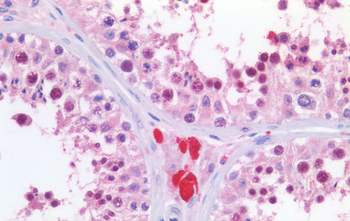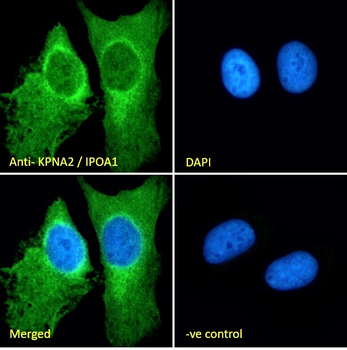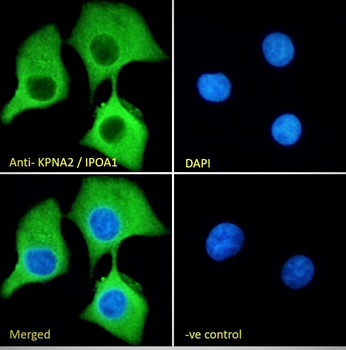You have no items in your shopping cart.
KPNA2/IPOA1 Antibody
Catalog Number: orb18623
| Catalog Number | orb18623 |
|---|---|
| Category | Antibodies |
| Description | Goat polyclonal antibody to KPNA2 |
| Target | KPNA2 / IPOA1 |
| Clonality | Polyclonal |
| Species/Host | Goat |
| Conjugation | Unconjugated |
| Reactivity | Human, Rat |
| Predicted Reactivity | Canine, Mouse |
| Buffer/Preservatives | Supplied at 0.5 mg/ml in Tris saline, 0.02% sodium azide, pH 7.3 with 0.5% bovine serum albumin. Aliquot and store at -20°C. Minimize freezing and thawing. |
| Purification | Purified from goat serum by ammonium sulphate precipitation followed by antigen affinity chromatography using the immunizing peptide. |
| Protein Sequence | QVQDGAPGTFNF |
| RRID | AB_10749322 |
| MW | 57.9 |
| Tested applications | ELISA, FC, IF, IHC, WB |
| Dilution range | ELISA: 1:32000, WB: 0.03-0.1 μg/ml, IHC-P: 5 μg/ml |
| Application notes | ELISA: Peptide ELISA: antibody detection limit dilution 1:8000.WB: Approx 55-60kDa band observed in Hela lysates (predicted size of approx. 58kDa according to NP_002257.1). Recommended for use at 0.1-0.5 μg/mlExperiment Notes: Immunofluoresence: in 4% formaldahyde-fixed HeLa staining is mostly cytoplasmic, with some nuclear staining and clear nuclear pore staining. |
| Storage | Maintain refrigerated at 2-8°C for up to 2 weeks. For long term storage store at -20°C in small aliquots to prevent freeze-thaw cycles. |
| Alternative names | anti KPNA2 antibody, anti IPOA1 QIP2 antibody, ant Read more... |
| Research Area | Epigenetics, Infectious Diseases |
| Note | For research use only |
| Entrez | 3838 |

5 μg/ml staining of paraffin embedded Human Testis. Steamed antigen retrieval with citrate buffer pH 6, AP-staining.

0.1 μg/ml staining of Jurkat (A) and CaCo-2 (B) and (0.03 μg/ml) A549 (C), MCF7 (D) and KNRK (E) cell lysate. (35 μg protein in RIPA buffer). Detected by chemiluminescence.

Immunofluorescence analysis of paraformaldehyde fixed U2OS cells, permeabilized with 0.15% Triton. Primary incubation 1hr (10 μg/ml) followed by Alexa Fluor 488 secondary antibody (2 μg/ml), showing cytoplasmic and ER/Golgi staining. The nuclear stain is DAPI (blue). Negative control: Unimmunized goat IgG (10 μg/ml) followed by Alexa Fluor 488 secondary antibody (2 μg/ml).

Immunofluorescence analysis of paraformaldehyde fixed A549 cells, permeabilized with 0.15% Triton. Primary incubation 1hr (10 μg/ml) followed by Alexa Fluor 488 secondary antibody (2 μg/ml), showing cytoplasmic staining. The nuclear stain is DAPI (blue). Negative control: Unimmunized goat IgG (10 μg/ml) followed by Alexa Fluor 488 secondary antibody (2 μg/ml).

Flow cytometric analysis of paraformaldehyde fixed A549 cells (blue line), permeabilized with 0.5% Triton. Primary incubation 1hr (10 μg/ml) followed by Alexa Fluor 488 secondary antibody (1 μg/ml). IgG control: Unimmunized goat IgG (black line) followed by Alexa Fluor 488 secondary antibody.
Goat anti-KPNA2 / IPOA1, Biotinylated Antibody [orb334066]
ELISA, IF, WB
Human
Goat
Polyclonal
Unconjugated
100 μgKPNA2 polyclonal antibody [orb646605]
IP, WB
Human, Mouse
Rabbit
Polyclonal
Unconjugated
200 μl, 100 μl, 50 μl
KPNA2/IPOA1 Antibody (orb18623)
Participating in our Biorbyt product reviews program enables you to support fellow scientists by sharing your firsthand experience with our products.
Login to Submit a Review






